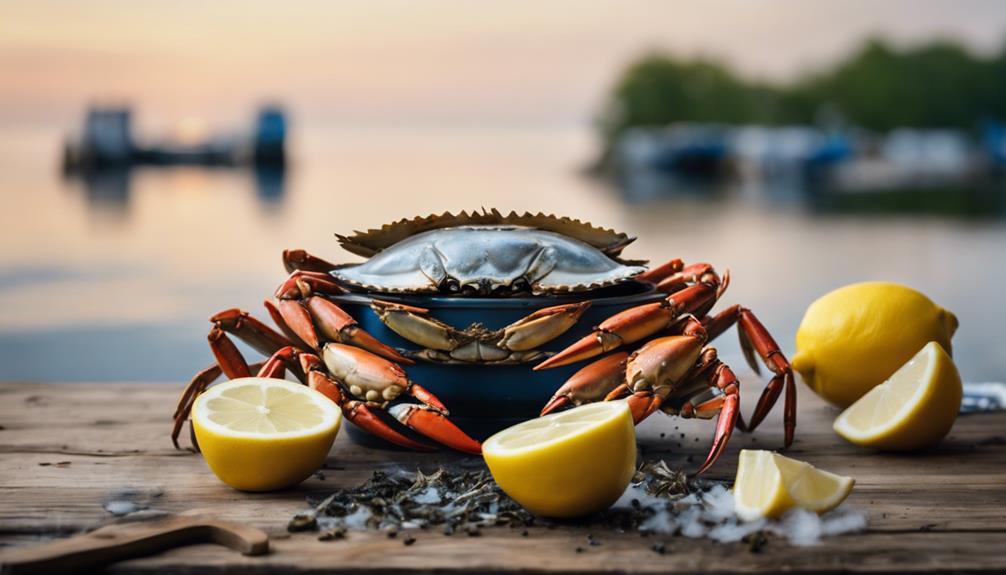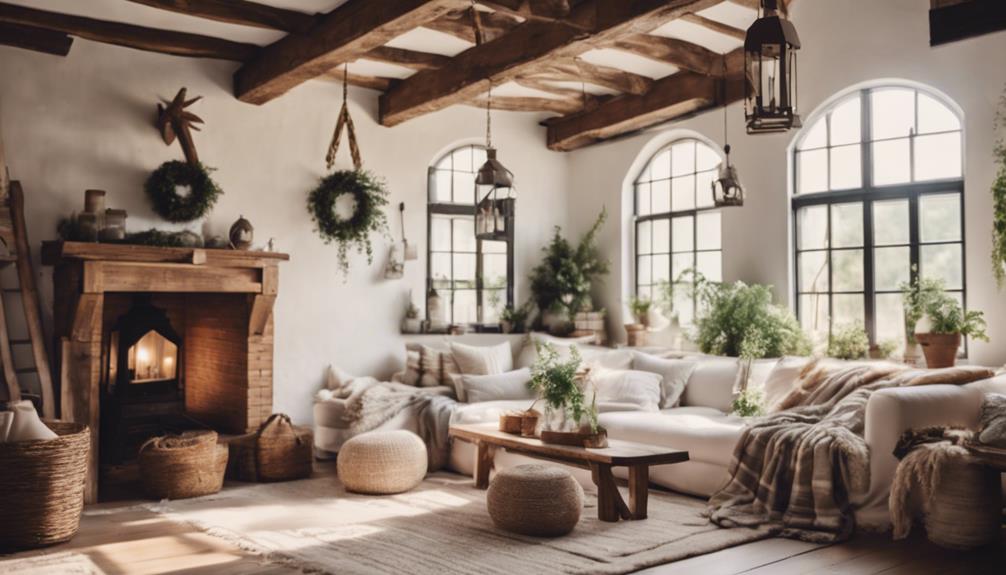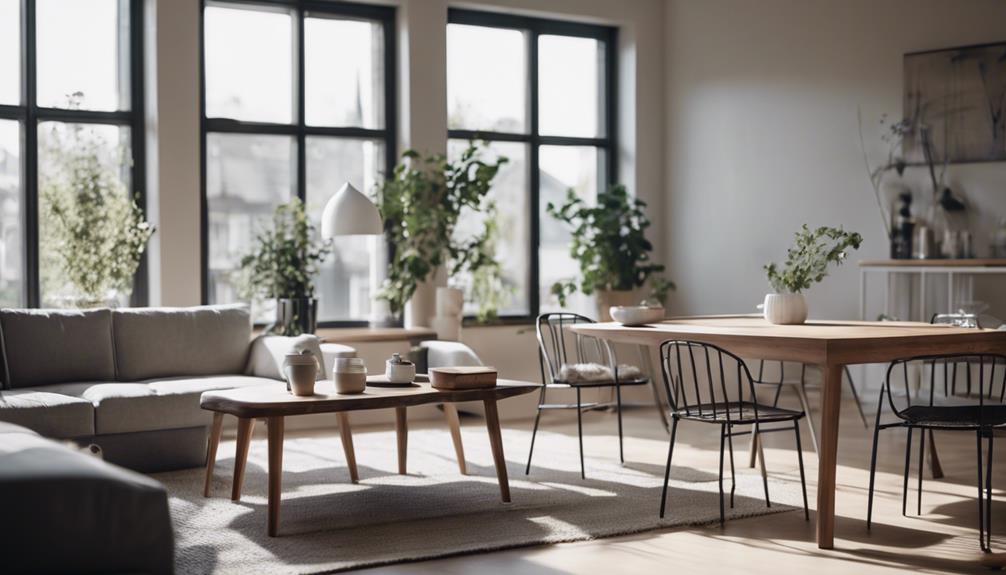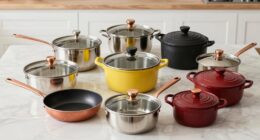Enjoying blue crabs goes beyond just having a tasty meal; it’s about embracing the rich Chesapeake tradition. To start, steam your crabs with Old Bay seasoning to lock in the flavor. Embrace the messy fun of cracking claws and legs while savoring each bite. Cover your table with newspapers and indulge in the communal experience, just like the locals. This seafood classic has deep historical roots and promotes sustainable practices to protect crab populations. If you’re interested in the best local crab shacks and seasonal events, there is plenty more to discover about this cherished culinary heritage.
Key Takeaways
- Steaming blue crabs with Old Bay or J.O. Spice enhances their natural flavor, making for a quintessential Chesapeake experience.
- Local dining options range from casual crab shacks to fine restaurants, offering diverse ways to savor blue crabs.
- Community crab feasts and festivals celebrate local culture, featuring music, crafts, and all-you-can-eat crab experiences.
- Respecting sustainable harvesting practices ensures the longevity of blue crab populations, vital for both the ecosystem and local economy.
Tips for Cooking Blue Crabs

To cook perfect blue crabs, start with a large, tall pot that has a tight-fitting lid to guarantee the steam stays inside.
Fill the pot with water, or for extra flavor, consider a mix of beer, water, and vinegar.
Make sure your crabs are alive before cooking; chilling them can keep them almost comatose.
For seasoning, don't hold back on Old Bay or J.O. Spice—they really enhance the flavor.
Steaming is the most popular cooking method, preserving the crabs' taste and texture.
Use a steam basket to keep the crabs out of the water, ensuring they cook evenly.
With these tips, you're well on your way to enjoying delicious blue crabs that everyone will love.
Eating Blue Crab Like a Local
Once you've mastered cooking blue crabs, it's time to embrace the fun and messy experience of eating them like a local. Start by covering your table with newspapers—trust us, you'll want to keep things tidy!
Here's a quick guide to help you savor each bite:
| Step | Action | Feelings |
|---|---|---|
| Preparation | Cover table with newspaper | Anticipation |
| Cracking Technique | Twist legs and claws | Excitement |
| Body Opening | Flip and remove the apron | Satisfaction |
| Innards Removal | Discard inedible parts | Adventure in flavor |
Dig in, enjoy the process, and don't be afraid to get a little messy. That's all part of the Chesapeake charm!
The History of Blue Crabs

Blue crabs have a rich history in the Chesapeake region, deeply intertwined with its culture and culinary traditions.
For centuries, these crustaceans have been a crucial food source for Native Americans and settlers alike. You'll find that blue crabs played a significant role in the local economy, contributing to the livelihoods of many families.
Their popularity surged in the 19th century, becoming a staple in local cuisine. The communal experience of eating blue crabs has fostered connections among residents, making it a cherished tradition.
Today, blue crabs symbolize both indulgence and environmental stewardship, highlighting the importance of sustainable practices to preserve this cherished resource for future generations.
Enjoying blue crabs is more than a meal; it's a celebration of heritage.
Sustainable Blue Crab Practices
Sustainable practices in blue crab harvesting guarantee the health of both the ecosystem and the local economy, benefiting future generations of crab lovers. To support these efforts, you can familiarize yourself with key sustainable practices:
| Practice | Description | Benefits |
|---|---|---|
| Harvesting Regulations | Strict guidelines to maintain crab populations | Guarantees long-term sustainability |
| Community Involvement | Local organizations advocate for responsible fishing | Promotes awareness and education |
| Seasonal Awareness | Understanding crab seasons for responsible harvesting | Helps maintain population health |
| Consumer Choices | Supporting local fisheries encourages sustainability | Positively impacts the local economy |
Local Dining Experiences

Plunge into the vibrant local dining scene where you can savor the freshest blue crab dishes, from casual crab shacks to upscale restaurants. Here's what you can experience:
- Crab Shacks: Enjoy freshly steamed crabs in a laid-back atmosphere. Many of these spots offer outdoor seating where you can feast with friends and family.
- Fine Dining: Treat yourself to gourmet blue crab creations that showcase local flavors and culinary artistry. You'll find dishes that elevate this beloved seafood to new heights.
- Community Events: Immerse yourself in crab feasts and festivals celebrating local cuisine. These gatherings foster community spirit and let you connect with fellow crab lovers while enjoying mouthwatering dishes.
No matter where you go, the Chesapeake blue crab experience is sure to delight!
Seasonal Crab Harvesting
Understanding the seasonal ebb and flow of crab harvesting is vital for enjoying this delicacy while helping maintain healthy populations.
Typically, the blue crab season runs from April to December, with peak harvesting occurring in late summer. During this time, you'll find the crabs at their most abundant and flavorful.
It's important to respect the regulations in place, as they're designed to protect the crab population and guarantee sustainability. When you harvest, consider the size and sex of the crabs; keeping the females and smaller crabs guarantees a thriving future harvest.
Community and Cultural Events

As you enjoy the seasonal bounty of blue crabs, community and cultural events centered around this beloved seafood bring people together to celebrate local traditions and flavors.
These gatherings create a vibrant atmosphere where everyone can indulge in delicious meals and build connections. Here are three popular community events you won't want to miss:
- Crab Feasts: Enjoy all-you-can-eat crab events where locals gather to savor crabs and share stories.
- Festivals: Annual festivals feature live music, local crafts, and crab-centric dishes, showcasing regional culture.
- Culinary Tours: Join guided tours to explore crab-centric eateries, learning cooking tips and tasting specialties.
These events not only highlight the culinary heritage but also foster a strong sense of community among residents and visitors alike.
How Can I Enjoy Blue Crabs in Virginia Beach?
When in Virginia Beach, don’t forget to discover hidden gems virginia beach like the local favorite, blue crabs. You can savor these delectable crustaceans at various seafood restaurants along the boardwalk or take a crabbing tour to catch your own and enjoy a traditional crab boil by the beach.
How Does Relocation to Wilhelmina Maine Affect the Tradition of Savoring Blue Crabs in Chesapeake?
The wilhelmina maine relocation journey to Wilhelmina, Maine may impact the tradition of savoring blue crabs in Chesapeake. With the move, individuals may have to adjust their seafood preferences due to the different availability of seafood in the region. However, they can still carry on the tradition by finding local alternatives.
Conclusion
As you crack into those tender blue crabs, each bite transports you deeper into the Chesapeake's rich tapestry of flavor and tradition.
You're not just savoring a meal; you're partaking in a celebration that binds generations together.
With every claw, you honor the local waters and the community that cherishes them.
So, gather your friends, share stories, and relish the experience—because in this sun-soaked paradise, every crab feast is a treasure waiting to be uncovered.









